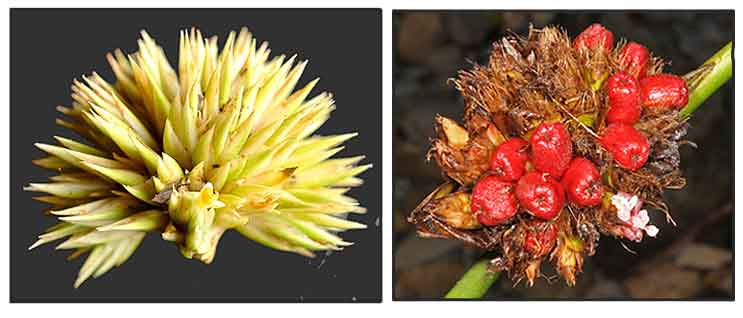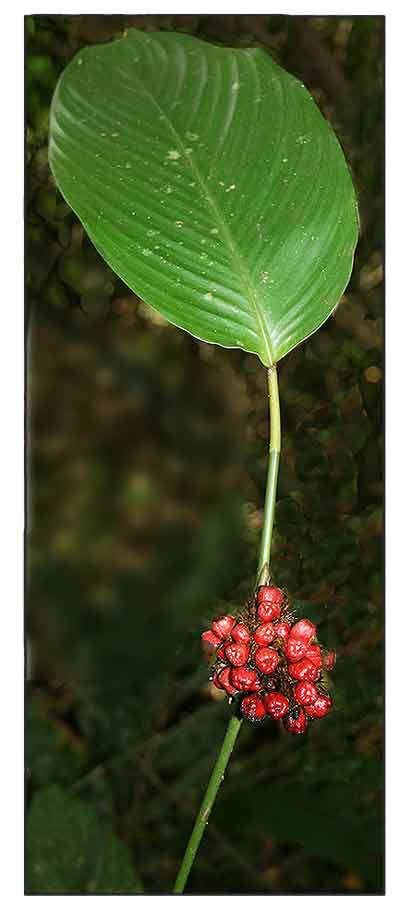 Gen info Gen info
- Phrynium was first described as a genus in 1797.
-
Phrynium pubinerve is the type species of the genus Phrynium in the family Marantaceae.
- As the name "packing leaf" implies, the plant is being touted, studied, and cultivated as a natural packing material and alternative
to plastics.
 Botany Botany
• Packing Leaf is a herb with creeping root stock. Leaves are elliptic-oblong, tapering, base rounded or blunt, up to 30 x 18 cm, leaf-stalk up to 60 cm long. Packing Leaf is used, since time immemorial, for packing and wrapping of food stuff, in many parts of NE India, in particular Arunachal Pradesh and Meghalaya. Flowers are borne in spherical, stalkless spikes, 4-6 cm across. Inner bracts are ovate-oblong, fringed at tip. Flower are yellow. Outer petal-like staminodes are orange-red. Lip has a drooping appendage. Ovary is woolly. (5)
• Rosulate plant 1-2(-3) m tall, sometimes forming dense clusters up to several meters in diameter. Leaf blade 23-82 x 9-30 cm. Inflorescence strongly congested, capitate, 4-8 cm in diameter, bracts subtending the proximal branches dark brown, partially sheathing the entire inflorescence, quickly withering and dissolving distally into a decaying fibrous mesh. Flowers pinkish-white, c. 18 mm long. Fruits bright red, c. 15 mm long, dehiscent. (2)
• Note: Phrynium pubinerve is readily recognized by its capitate inflorescence, with tattering brown bracts, and red capsular fruits with gray seeds. Plants are strongly variable in size at reproductive maturity. The Philippine population has been described as separate species, P. philippinense, but shows no differential characters relative to populations of P. pubinerve in other areas. (2)
Distribution
- Native to the Philippines. (1)
- Also native to Andaman Is., Assam, Bangladesh, Borneo, Cambodia, China South-Central, China Southeast, East Himalaya, India, Jawa, Laos, Malaya, Myanmar, New Guinea, Sri Lanka, Sulawesi, Sumatera, Thailand, Vietnam. (1)
Constituents
- Study of leaves of Phrynium pubinerve for essential oil. P. pubinerve yielded 46 components, representing 88.57% of oil. The EOs was rich in alipathic alcohols, aromatics, oxygenated monoterpenes and diterpenes. Major constituents of P. pubinerve were (Z)-3- hexen-1-ol (17.31%), (E)-2-hexenal (9.01%) and 1-hexanol (8.61%), and for T. latifoliawere (Z)-3-hexen-1-ol (28.79%), phytol (12.30) and (E)-b-ionone (9.54%). (see study below) (4)
Properties
- Studies have suggest antibacterial, antioxidant, antidiabetic, anti-inflammatory, anti-allergy properties.
Parts used
Leaves, rhizomes, oil.
Uses
Edibility
- In the Eastern Himalayan region of India, seeds reportedly eaten raw.
Folkloric
- No reported folkloric medicinal use in the Philippines.
- In various folkloric treatments, leaves are used as vehicle to wrap mixtures of ground herbal ingredients, covered with ash to avoid burning, heated
over fire, and contents fomented on affected body parts.
-
In India, the Mech tribe in Duars of Paschimbanga use the leaves for "contact therapy": Children suffering from malnutrition are made to lay down on the plant leaf for one month; simultaneously, a small part of the skull of Macaca mullatta is tied with a string and hung around the neck. (8)
- The Dai and Hani people in Xishuangbanna use the leaves of P. pubinerve, along with Thysanolaena latifolia, as traditional remedies for relief of coughs, fever, detoxification, and stomach disorders. (10)
- Plant used along with several other plants for treatment of leprosy by ethnic people in the Eastern Himalayan region. (11) Warmed leaves applied to muscle pains and sprains. (12) Rhizome paste applied to boils.
-
In Bangladesh, Kanda tribal people use the plant for earache: Whole plant is warmed over fire until the sap starts oozing out, and 2-3 drops of sap is instilled into the ears. (11)
- "People-Forest-Miang" communities in Mae Kampong Village in Thailand use water soaked with Phrynium pubinerve roots to reduce hangover symptoms. (13)
- In Laos, tong tying is used for skin problems; powdered leaves are used as plaster for edema. Decoction of roots drunk for hangovers. (14)
- Juice from stem used for irritant eyes. (15)
Others
- Packaging / Tying: Leaves used as packaging material for vegetables and meat. (9) The use of P. pubinerve leaves as packaging material and its antiseptic function was reported in China c. 304 AD. (10) Many Southeast Asian tribes use the distinctly aromatic leaf to wrap and prepare food for the aroma contributes to the cuisine, an aroma unfamiliar to modern cooking. (•) In Vietnam's culinary culture, the King Hung legend mentions Chung cake wrapped in La dong leaves (Phrynium spp.), green representing earth and Day cake of white sticky rice representing heaven.
- Crafts:
As waterproof materials used for making rain hats, umbrellas, and to roof huts in India. Stems used for for weaving or to keep roof thatching in place. (9) (15)
- Culture: For a good harvest, the Mishing tribe of Jorhat, Assam, India, wrapped all agricultural implements with the leaves of P. pubinerve on the first day of sowing. (9)
Studies
• Antibacterial / Antioxidant / Essential Oil / Leaves: Study of evaluated leaves of Phrynium pubinerve and Thysanolaena latifolia for essential oil, antioxidant and antibacterial activities. On DPPH assay, the EO and ethanol extract showed IC50s of 706.07 and 220.65 µg/ml, respectively; ABTS assay showed IC50s of 134.97 and 60.57 µg/ml, respectively. The two essential oils were active against all tested pathogenic bacteria and spoilage organisms, with inhibition zones range of 9.00 to 15.33 mm at 20 mg/ml, while the ethanol extracts were only active against A. baumannii, E. coli, K. pneumonia, and P. aeruginosa. The EOs showed broader antimicrobial activities than the ethanol extracts. (see constituents above) (4)
• Antidiabetic / Leaves: Study evaluated the effect of P. pubinerve leaves on decreasing blood glucose level on alloxan-induced diabetic rats. Glibenclamide was used as standard. Four groups were treated with doses of 250, 625, 2500, and 4500 mg/kbw. While all doses were able to decrease blood sugar, the most effective leave dose was 2500 mg/kbw dose. (6)
• Syringic Acid / Attenuation of Allergic Inflammation / Leaves: Study evaluated the role of ethanolic leaf extract of syringic acid-rich P. pubinerve supplement in attenuating allergic inflammation. The extract strongly suppressed NO and ROS.RNS production and significantly down-regulated iNOS, COX-2, NF-kB, IL-6 and TNF-α signaling. Results showed the extract ameliorated TDI-induced allergy-like symptoms and decreased different inflammatory WBCs in mice's blood and BAL fluid in a dose-dependent manner. Safe use in animals was evidenced by both acute and sub-acute toxicity studies. (7)
Availability
- Wild-crafted.
- Seeds in the cybermarket.
|

![]()



 Gen info
Gen info
